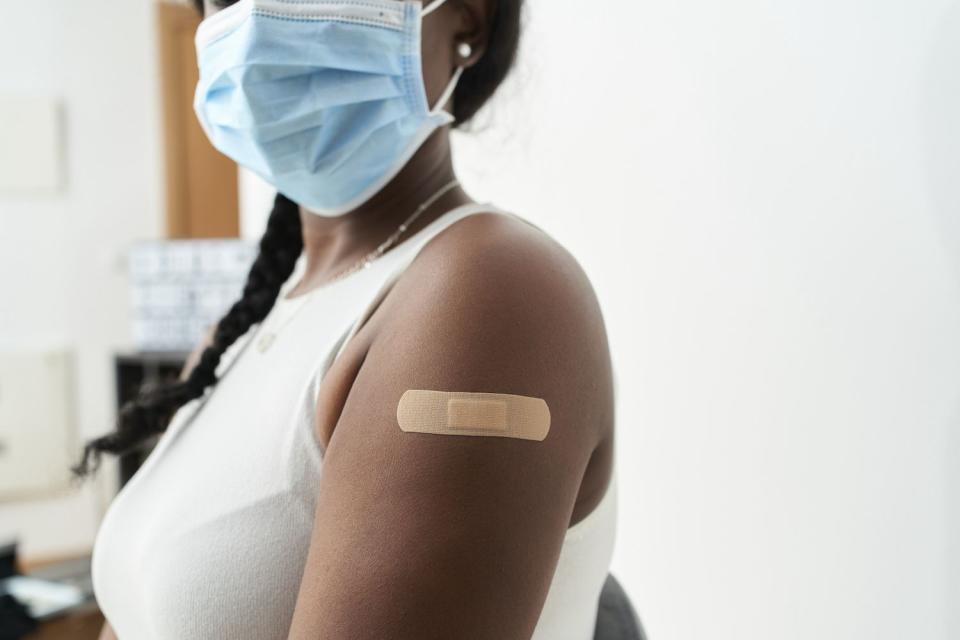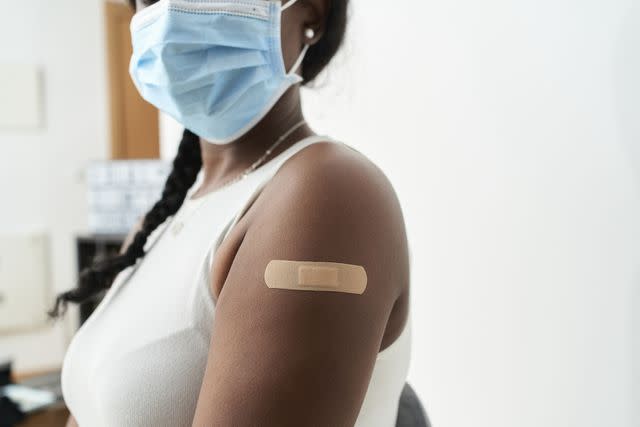Shingles Vaccine Side Effects
A sore arm and flu-like symptoms are common

Aire Images / Getty Images
Medically reviewed by Anju Goel, MD, MPH
Common side effects of the shingles vaccine (Shingrix) are mild pain and redness at the injection site. Some people have fatigue, headache, and fever after getting the shingles shot. The side effects of Shingrix may last for a few days but are not serious. More serious side effects after a shingles shot, like an allergic reaction, are rare.
The shingles vaccination helps prevent shingles (herpes zoster) and complications of the illness, such as nerve pain. While it’s important to know about the potential side effects of the shingles vaccine, the benefits of vaccination usually outweigh concerns about side effects.
This article looks at shingles vaccine side effects. It also provides information about shingles symptoms and complications, who should and shouldn't get the shingles vaccine, and what you can do to recover from shingles vaccine side effects if you have them.

Aire Images / Getty Images
Learn More: What Does Shingles Look Like?
Common Side Effects of the Shingles Vaccine
Studies have shown that the shingles vaccine is safe. If people do have side effects after the shot, they are usually not serious and do not last long. Common side effects of the shingles vaccine include:
Mild to moderate pain in the injection arm
Redness and swelling at the injection site
Fatigue
Muscle pain
Headache
Fever and chills
Stomach pain
Nausea
When They Start, How Long They Last
The shingles vaccine is given in a two-shot series that you get two-six months apart. You may have side effects after the first, second, or both shots. Some people tend to feel certain symptoms like muscle pain and headache after they get the second dose, but everyone is different.
The side effects of a shingles vaccine are mild and will come on immediately after you get the shot. Shingles vaccine side effects typically only last for two or three days.
Side effects of the shingles vaccine tend to be more common in younger people. They are usually mild but might get in the way of your normal daily activities for a few days.
While side effects can feel like a downside of the shingles vaccine, keep in mind that the symptoms you’re having mean that your immune system is learning to build a defense against the shingle virus—which is what the vaccine is meant to do.
You can ask your provider if it’s OK to take Tylenol (acetaminophen) or Advil (ibuprofen) after a shingles vaccine to help with your symptoms. Generally taking it easy for a few days and drinking plenty of fluids can help, too.
How Often Do You Need a Shingles Vaccine?
Shingrix is a two-dose series. You should get the doses between two and six months apart.
Learn More: How to Tell If You Have Shingles
Rare Side Effects of the Shingles Vaccine
In rare cases, a severe allergic reaction (anaphylaxis) can happen after a shingles vaccine. It’s a life-threatening emergency that needs immediate medical attention.
Symptoms of anaphylaxis after receiving the shingles vaccine include:
Swelling of the face/throat
Difficulty breathing
Dizziness
Weakness
These side effects usually start immediately or within a few minutes of vaccination (in which case medical providers may be nearby and can help). If you have symptoms of anaphylaxis after you get home from getting your shingles shot, call 911.
Reporting Side Effects
If you have side effects from the shingles vaccine, the CDC recommends reporting them to the Vaccine Adverse Event Reporting System (VAERS) by calling 1-800-822-7967. Your healthcare provider may also file this report for you.
Learn More: Vaccine Side Effects vs. Adverse Effects
Can the Shingles Shot Cause Guillain-Barré Syndrome?
It’s rare, but a condition called Guillain-Barré syndrome can happen after the shingles vaccine or after you’ve had the shingles virus. The symptoms include loss of sensation and muscle paralysis that comes on fast, typically spreading up from the lower half of your body (e.g., legs).
Guillain-Barré syndrome can be life-threatening, so contact a healthcare provider right away if you think you may have symptoms after getting a shingles shot.
How Long Are You Contagious After the Shingles Vaccine?
You are not contagious after you get the shingles shot. The shingles vaccine does not give you the shingles virus. You cannot spread shingles to someone after you have the vaccine.
You also cannot get chickenpox from the shingles vaccine or spread the chickenpox to someone after you have the shingles shot. However, if you notice a chickenpox-like rash on your skin where you got the shot, it’s best to cover it up until it heals.
Related: Guillain-Barré: What to Expect During Recovery
Who Should Get the Shingles Vaccine
The CDC recommends the following people get a shingles vaccine:
Adults aged 50 and older
Adults who have never had shingles
Adults who have had shingles before (it's possible to get shingles multiple times)
Adults who are not sure whether they had chickenpox
Adults who were previously vaccinated with the Zostavax shingles vaccine (which is no longer available in the United States)
Adults aged 19 or older and adults who are (or will be) immunodeficient or immunosuppressed because of disease or treatment
Can You Get the Shingles Vaccine at the Same Time as Other Vaccines?
It is safe for you to get a shingles vaccine at the same time as many others, including the COVID-19 and flu vaccines. Your healthcare provider will want to use different sites on your body for the shots, so you may be sore in more than one arm.
Learn More: Should You Get the Shingles Vaccine?
Weighing the Risks vs. Benefits
The vaccine to prevent shingles will help you to avoid shingles symptoms. While some people only get a mild case of shingles, it can cause severe illness, pain, and complications in other people.
Shingles symptoms usually come in stages, though how the infection progresses can be a little different for everyone. In the first stage of shingles, your symptoms may include:
About three to five days later, you’ll get a prickly, painful pimple-like rash. In the eruptive stage, the pimples turn into blisters, and your skin can be red and swollen. Shingles sores also can affect your mouth.
Shingles is generally not life-threatening unless you have a weakened immune system. During an outbreak of shingles and after the rash clears up, some people might get complications that require immediate medical attention.
Takeaway
Clinical trials have shown that Shingrix prevents shingles in at least 91% of people 50 and older. That age group is the most at risk of developing shingles.
Common shingles complications include:
Postherpetic neuralgia (PNH) (damaged nerves cause lingering pain for three months or more)
Bacterial skin infections (when shingles blisters pop, bacteria can get in)
Eye damage (one branch of the trigeminal nerve goes to the eye and causes serious damage)
What If I Got Zostavax?
If you were vaccinated with Zostavax—a shingles vaccine that is no longer being given—ask your healthcare provider about getting the Shingrix vaccine.
Learn More: What to Know About Your Second Shingrix Dose
Who Should Not Get It
The CDC says that some people should not get the shingles vaccine:
People who have ever had a severe allergic reaction to any component of the vaccine or after a dose of Shingrix
People who have tested negative for VZV immunity (which means they have not had chickenpox and should get the chickenpox vaccine instead)
People who currently have shingles
People who are currently pregnant
People who are currently sick with a severe or moderate acute illness, such as a respiratory infection
Your healthcare provider can answer any questions you have about whether the vaccine is safe for you.
Learn More: Shingles Vaccine Options
How to Reduce Shingles Shot Side Effects
You cannot necessarily prevent side effects from a shingles shot and there isn’t much you can do to make them go away faster.
In general, taking it easy for the rest of the day after your vaccine, getting plenty of rest, staying hydrated, and making quality sleep a priority will help your body do the important job of preparing itself to fight off a shingles infection in the future.
Learn More: How to Avoid Shingles
Summary
Getting a shingles vaccine is the only way to prevent shingles. While you can have some mild side effects, the benefits of the shingles shot outweigh the risk of side effects or rare complications for most people.
If you’re not sure if you can and should get a shingles vaccine, talk to your provider. While the shot is safe and effective for most people who are eligible for it, there are some situations where you might not want to get it or you may want to delay getting the vaccine—for example, if you’re currently sick or pregnant.

